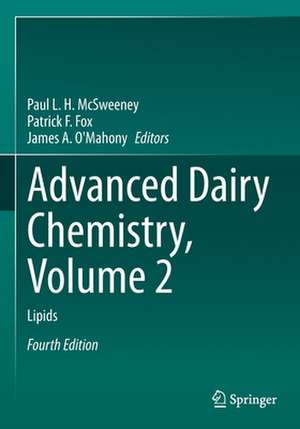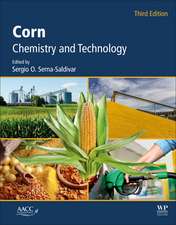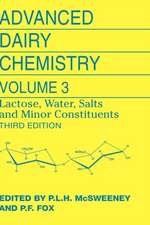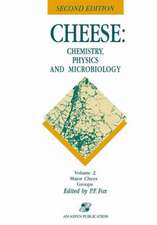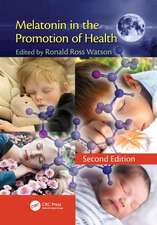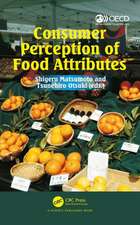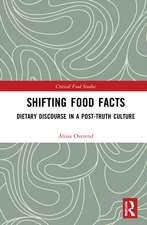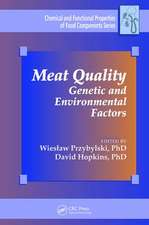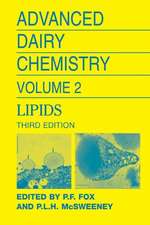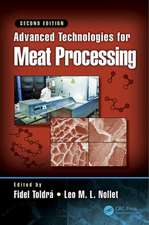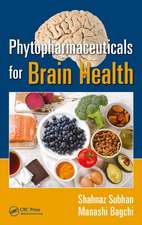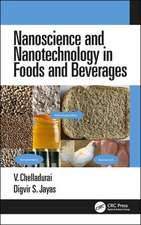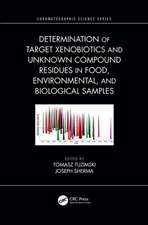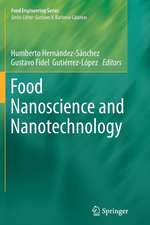Advanced Dairy Chemistry, Volume 2: Lipids
Editat de Paul L. H. McSweeney, Patrick F. Fox, James A. O'Mahonyen Limba Engleză Paperback – 9 dec 2021
Advanced Dairy Chemistry Volume 2: Lipids, Fourth Edition, is unique in the literature on milk lipids, a broad field that encompasses a diverse range of topics, including synthesis of fatty acids and acylglycerols, compounds associated with the milk fat fraction, analytical aspects, behavior of lipids during processing and their effect on product characteristics, product defects arising from lipolysis and oxidation of lipids, as well as nutritional significance of milk lipids.
In the years since the publication of the third edition there have been significant developments in milk lipids and these are reflected in changes to this volume. Most topics included in the third edition are retained in the current edition, which has been updated; in some cases, new authors have given their perspective on certain topics. Chapters on nutritional significance of dairy lipids have been considerably revised. This authoritative work summarizes current knowledge on milk lipids and suggests areas for further work. It will be very valuable to dairy scientists, chemists and others working in dairy research or in the dairy industry.
| Toate formatele și edițiile | Preț | Express |
|---|---|---|
| Paperback (1) | 905.85 lei 6-8 săpt. | |
| Springer International Publishing – 9 dec 2021 | 905.85 lei 6-8 săpt. | |
| Hardback (1) | 1403.67 lei 6-8 săpt. | |
| Springer International Publishing – 8 dec 2020 | 1403.67 lei 6-8 săpt. |
Preț: 905.85 lei
Preț vechi: 1104.69 lei
-18% Nou
Puncte Express: 1359
Preț estimativ în valută:
173.36€ • 180.32$ • 143.12£
173.36€ • 180.32$ • 143.12£
Carte tipărită la comandă
Livrare economică 14-28 aprilie
Preluare comenzi: 021 569.72.76
Specificații
ISBN-13: 9783030486884
ISBN-10: 3030486885
Ilustrații: XVII, 489 p. 106 illus., 16 illus. in color.
Dimensiuni: 178 x 254 mm
Greutate: 0.87 kg
Ediția:4th ed. 2020
Editura: Springer International Publishing
Colecția Springer
Locul publicării:Cham, Switzerland
ISBN-10: 3030486885
Ilustrații: XVII, 489 p. 106 illus., 16 illus. in color.
Dimensiuni: 178 x 254 mm
Greutate: 0.87 kg
Ediția:4th ed. 2020
Editura: Springer International Publishing
Colecția Springer
Locul publicării:Cham, Switzerland
Descriere
The Advanced Dairy Chemistry series was first published in four volumes in the 1980s (under the title Developments in Dairy Chemistry) and revised in three volumes in the 1990s. The series is the leading reference on dairy chemistry, providing in-depth coverage of milk proteins, lipids, lactose, water and minor constituents.
Advanced Dairy Chemistry Volume 2: Lipids, Third Edition, is unique in the literature on milk lipids, a broad field that encompasses a diverse range of topics, including synthesis of fatty acids and acylglycerols, compounds associated with the milk fat fraction, analytical aspects, behavior of lipids during processing and their effect on product characteristics, product defects arising from lipolysis and oxidation of lipids, as well as nutritional significance of milk lipids.
Most topics included in the second edition are retained in the current edition, which has been updated and considerably expanded. New chapters cover the following subjects: Biosynthesis and nutritional significance of conjugated linoleic acid, which has assumed major significance during the past decade; Formation and biological significance of oxysterols; The milk fat globule membrane as a source of nutritionally and technologically significant products; Physical, chemical and enzymatic modification of milk fat; Significance of fat in dairy products: creams, cheese, ice cream, milk powders and infant formulae; Analytical methods: chromatographic, spectroscopic, ultrasound and physical methods.
This authoritative work summarizes current knowledge on milk lipids and suggests areas for further work. It will be very valuable to dairy scientists, chemists and others working in dairy research or in the dairy industry.
Advanced Dairy Chemistry Volume 2: Lipids, Third Edition, is unique in the literature on milk lipids, a broad field that encompasses a diverse range of topics, including synthesis of fatty acids and acylglycerols, compounds associated with the milk fat fraction, analytical aspects, behavior of lipids during processing and their effect on product characteristics, product defects arising from lipolysis and oxidation of lipids, as well as nutritional significance of milk lipids.
Most topics included in the second edition are retained in the current edition, which has been updated and considerably expanded. New chapters cover the following subjects: Biosynthesis and nutritional significance of conjugated linoleic acid, which has assumed major significance during the past decade; Formation and biological significance of oxysterols; The milk fat globule membrane as a source of nutritionally and technologically significant products; Physical, chemical and enzymatic modification of milk fat; Significance of fat in dairy products: creams, cheese, ice cream, milk powders and infant formulae; Analytical methods: chromatographic, spectroscopic, ultrasound and physical methods.
This authoritative work summarizes current knowledge on milk lipids and suggests areas for further work. It will be very valuable to dairy scientists, chemists and others working in dairy research or in the dairy industry.
Cuprins
Composition and structure of milk lipids 1AKH MacGibbon
Content and physical form of fat in milk, fatty acid profile, interspecies comparison, structure of milk lipids including interspecies comparison.2
Origin of fatty acids and influence of nutritional factors on milk fat
Origins of fatty acids, biosynthesis of fatty acids and other milk lipids, variation in milk fat: yield and fatty acid composition
3
Conjugated linoleic acid: biosynthesis and nutritional significance
DE Bauman
Biosynthesis of CLA, levels in milk and dairy products, nutritional significance (analytical techniques?)
4
Intracellular origin of milk lipid globules; nature and structure of milk lipid globule membrane. Heterogeneity, molecular and biological properties of proteins
IH Mather
Intracellular origin and growth of lipid globules, intracellular transit of lipid globules, secretion of globules, composition and isolation of globule membrane, proteins and enzymes of membrane, molecular organization of membrane
5
Lipids in human milk
????
Concentration of lipids in human milk, changes during lactation, fatty acid profile, fat globule structure, creaming, fat globule membrane.
6
Physical chemistry of milk fat globules
AL Kelly
(To include thorough discussion on creaming; T Uniacke-Lowe). Globule size distribution, compositional differences, fat crystals in globules, types of instability, interaction energy, cold agglutination, creaming, coalescence, partial coalescence, rebodying, disruption, changes in surface layers, “free fat”, properties of modified fat globules, homogenisation clusters, rheological properties of milk.
7
Composition, applications, fractionation, technological and/or nutritional significance of milk fat globule material
M Corredig
8
Milk fat: chemical and physical modification, fractional crystallization, removal of cholesterol
MA Augustin
Rheological properties of milk fat (composition and melting behaviour, spredibility, seasonaility), viscoelastic nature, modification of rheological proerties.
9
Crystallization and rheological properties of milk fat spreads
AG Marangoni
Melting range, nucleation and growth, polymorphism, compound crystals, recrystallization, modification, crystal networks.
10
Role of milkfat in dairy products
AL Kelly to coordinate
Butter, spreads, creams, cheese, ice cream, powders, IMF, chocolate11
Nutritional significance of milk lipids
Types of lipids in the body and their functions, types of lipids in foods, metabolism of lipids, roles of food lipids, dietary lipids in health and disease.
12
Physical characteristics of milk fat
OJ MacCarthy
Owen MacCarthy’s chapter…
13
Analytical methods
DJ McClements?
Traditional and new methods of quantitation, liquid and solid fat, rheological properties, lipid oxidation, FFA, globular and non-globular fat, fatty acid profile, stereo analysis.
Content and physical form of fat in milk, fatty acid profile, interspecies comparison, structure of milk lipids including interspecies comparison.2
Origin of fatty acids and influence of nutritional factors on milk fat
Origins of fatty acids, biosynthesis of fatty acids and other milk lipids, variation in milk fat: yield and fatty acid composition
3
Conjugated linoleic acid: biosynthesis and nutritional significance
DE Bauman
Biosynthesis of CLA, levels in milk and dairy products, nutritional significance (analytical techniques?)
4
Intracellular origin of milk lipid globules; nature and structure of milk lipid globule membrane. Heterogeneity, molecular and biological properties of proteins
IH Mather
Intracellular origin and growth of lipid globules, intracellular transit of lipid globules, secretion of globules, composition and isolation of globule membrane, proteins and enzymes of membrane, molecular organization of membrane
5
Lipids in human milk
????
Concentration of lipids in human milk, changes during lactation, fatty acid profile, fat globule structure, creaming, fat globule membrane.
6
Physical chemistry of milk fat globules
AL Kelly
(To include thorough discussion on creaming; T Uniacke-Lowe). Globule size distribution, compositional differences, fat crystals in globules, types of instability, interaction energy, cold agglutination, creaming, coalescence, partial coalescence, rebodying, disruption, changes in surface layers, “free fat”, properties of modified fat globules, homogenisation clusters, rheological properties of milk.
7
Composition, applications, fractionation, technological and/or nutritional significance of milk fat globule material
M Corredig
8
Milk fat: chemical and physical modification, fractional crystallization, removal of cholesterol
MA Augustin
Rheological properties of milk fat (composition and melting behaviour, spredibility, seasonaility), viscoelastic nature, modification of rheological proerties.
9
Crystallization and rheological properties of milk fat spreads
AG Marangoni
Melting range, nucleation and growth, polymorphism, compound crystals, recrystallization, modification, crystal networks.
10
Role of milkfat in dairy products
AL Kelly to coordinate
Butter, spreads, creams, cheese, ice cream, powders, IMF, chocolate11
Nutritional significance of milk lipids
Types of lipids in the body and their functions, types of lipids in foods, metabolism of lipids, roles of food lipids, dietary lipids in health and disease.
12
Physical characteristics of milk fat
OJ MacCarthy
Owen MacCarthy’s chapter…
13
Analytical methods
DJ McClements?
Traditional and new methods of quantitation, liquid and solid fat, rheological properties, lipid oxidation, FFA, globular and non-globular fat, fatty acid profile, stereo analysis.
Notă biografică
Paul McSweeney is Professor of Food Chemistry and former Head of the School of Food and Nutritional Sciences in University College Cork, Ireland where he is currently the university’s Vice-President for Learning and Teaching. He has an active research profile in dairy chemistry and cheese science and is the co-author or co-editor of 15 books in addition to numerous research papers. He was awarded the Marschall Danisco International Dairy Science Award of the American Dairy Science Association in 2004 and in 2009 a higher doctorate (DSc) on published work by the National University of Ireland.Patrick F. Fox BSc, PhD, DSc, CChem, FRSC, FICI was Professor and Head of the Department of Food Chemistry at University College, Cork, Ireland, from 1969 to 1997; he retired in December 1997 and is now Emeritus Professor of Food Chemistry. Prof. Fox received PhD degree in Food Chemistry from Cornell University followed by postdoctoral periods in the United States. Prof. Fox’s research has focused on the biochemistry of cheese, the heat stability of milk, physicochemical properties of milk proteins, and food enzymology. He has authored or coauthored about 530 research and review papers, and authored or edited 25 text books on Dairy Chemistry. He was one of the founding editors of the International Dairy Journal. In recognition of his work, Prof. Fox has received the Research & Innovation Award of the (Irish) National Board for Science and Technology (1983), the Miles-Marschall Award of the American Dairy Science Association (1987), Medal of Honour, University of Helsinki (1991), the DSc degree of the National University of Ireland (1993), the Senior Medal for Agricultural & Food Chemistry of the Royal Society for Chemistry (2000), the ISI Highly Cited Award in Agricultural Science (2002), the International Dairy Federation Award (2002), Gold Medal of the UK Society of Dairy Technology (2007), and an autobiography published in Annual Review of Food Science & Technology (2011). Prof. Fox has been invited to lecture in various countries around the world.
James O’Mahony is a Lecturer in Food Science in the School of Food and Nutritional Sciences at University College Cork. He is the group leader and principal investigator for the food ingredients research group within the School, which is one of the largest, most active research groups within the School. He has co-authored and co-edited 15 books and book chapters, in addition to more than 100 research and review articles over the last 10 years.
James O’Mahony is a Lecturer in Food Science in the School of Food and Nutritional Sciences at University College Cork. He is the group leader and principal investigator for the food ingredients research group within the School, which is one of the largest, most active research groups within the School. He has co-authored and co-edited 15 books and book chapters, in addition to more than 100 research and review articles over the last 10 years.
Textul de pe ultima copertă
The Advanced Dairy Chemistry series was first published in four volumes in the 1980s (under the title Developments in Dairy Chemistry) and revised in three volumes in the 1990s and 2000s. The series is the leading reference on dairy chemistry, providing in-depth coverage of milk proteins, lipids, lactose, water and minor constituents.
Advanced Dairy Chemistry Volume 2: Lipids, Fourth Edition, is unique in the literature on milk lipids, a broad field that encompasses a diverse range of topics, including synthesis of fatty acids and acylglycerols, compounds associated with the milk fat fraction, analytical aspects, behavior of lipids during processing and their effect on product characteristics, product defects arising from lipolysis and oxidation of lipids, as well as nutritional significance of milk lipids.
In the years since the publication of the third edition there have been significant developments in milk lipids and these are reflected in changes to this volume. Most topics included in the third edition are retained in the current edition, which has been updated; in some cases, new authors have given their perspective on certain topics. Chapters on nutritional significance of dairy lipids have been considerably revised. This authoritative work summarizes current knowledge on milk lipids and suggests areas for further work. It will be very valuable to dairy scientists, chemists and others working in dairy research or in the dairy industry.
Advanced Dairy Chemistry Volume 2: Lipids, Fourth Edition, is unique in the literature on milk lipids, a broad field that encompasses a diverse range of topics, including synthesis of fatty acids and acylglycerols, compounds associated with the milk fat fraction, analytical aspects, behavior of lipids during processing and their effect on product characteristics, product defects arising from lipolysis and oxidation of lipids, as well as nutritional significance of milk lipids.
In the years since the publication of the third edition there have been significant developments in milk lipids and these are reflected in changes to this volume. Most topics included in the third edition are retained in the current edition, which has been updated; in some cases, new authors have given their perspective on certain topics. Chapters on nutritional significance of dairy lipids have been considerably revised. This authoritative work summarizes current knowledge on milk lipids and suggests areas for further work. It will be very valuable to dairy scientists, chemists and others working in dairy research or in the dairy industry.
Caracteristici
Provides detailed scientific information on all aspects of milk lipids
Updates previous findings
Introduces new information on butter making, dairy products and cholesterol, and milk fats
Updates previous findings
Introduces new information on butter making, dairy products and cholesterol, and milk fats
